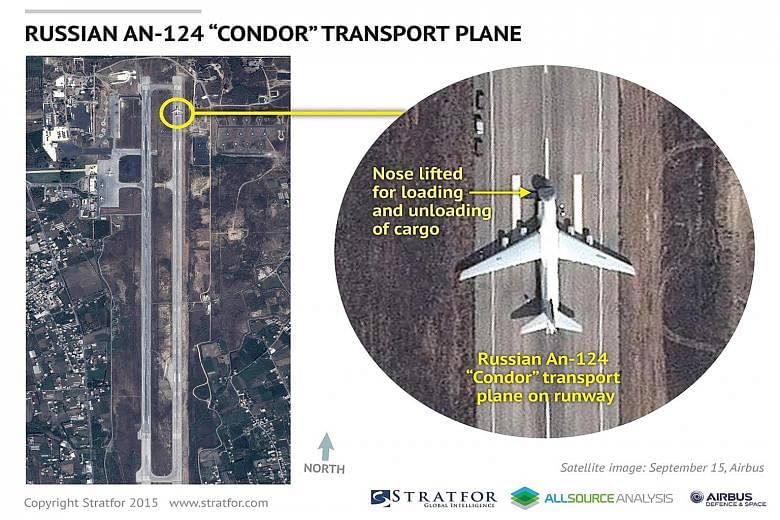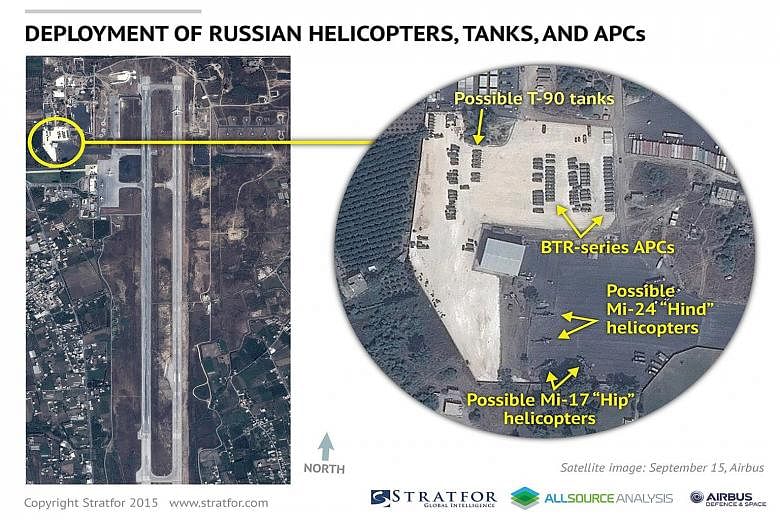LONDON • As the first Russian combat aircraft arrived in Syria, the Obama administration reached out to Moscow to try to coordinate actions in the war zone and avoid an accidental escalation of one of the world's most volatile conflicts.
The diplomatic initiative amounted to a pivot for the White House, which just two weeks ago delivered a stern warning to the Kremlin that its military build-up in Syria risked an escalation of the civil war there or even an inadvertent confrontation with the United States.
The Russians have sent tanks, marines and, now, combat aircraft to a new military hub near Latakia in western Syria. The Americans have flown hundreds of air missions in Syria striking the Islamic State in Iraq and Syria (Isis).
Last week, US President Barack Obama condemned Russia's move as a "strategy that's doomed to failure". But the White House seemed to acknowledge that the Kremlin had effectively changed the calculus in Syria in a way that would not be soon reversed despite vigorous US objections. The decision to start talks also reflected a hope that Russia might yet be drawn into a more constructive role in resolving the four-year-old civil war.
At Mr Obama's instruction, Defence Secretary Ash Carter on Friday opened a dialogue on Syria with his Russian counterpart, Mr Sergei K. Shoigu. But while Mr Carter's initial military-to-military talks were limited in scope, officials indicated that the larger goal was to draw the Russians into a political process that would ultimately replace Syrian President Bashar al-Assad, a longtime ally of the Kremlin.
Still, the stakes have become even higher, as a senior US official on Friday confirmed that four Russian Su-27 aircraft had been deployed to the airbase in recent days, along with four large troop-transport helicopters and four Hind helicopter gunships. The official, who spoke on the condition of anonymity, said that more than 20 Condor transport plane flights had delivered weapons and equipment to the airbase in the past 10 days.
The Russian military build-up in Syria could serve the Kremlin's interests in several ways. It could help strengthen Mr Assad, whom Russia has long backed and who has suffered a number of military reversals in recent months. It could put Moscow in a stronger position to shape the formation of a new Syrian government if Mr Assad is pushed out of power.
It also helps Russia cement its strategic interests in what experts say is its most important new Middle East military outpost in decades. Some former diplomats view the Russian move as a brazen effort to undercut US influence in the region.
"The whole region is watching this," said Mr James Jeffrey, a former US ambassador to Iraq and Turkey. "Russia is trying to change the security dynamics in the Middle East and demonstrating that it supports its allies to the hilt.
" The White House is sitting there and worrying about de-conflicting airplanes when we should be upping our efforts against Mr Assad."
But after failing to impede the build-up by convincing nations to close their airspace to Russian transport planes - Bulgaria banned the flights but Iraq did not - the White House is trying to make the best out of a situation it feels it is powerless to prevent.
Reuters news agency reported last week that Syrian forces had already started using new types of "very accurate" air and ground weapons supplied by Russia.
Syrian army jets carried out, at least, 25 air strikes on the Isis-held city of Palmyra on Friday, a group monitoring the war said, the second intense bombardment in two days of territory held by Isis militants. The Syrian Observatory for Human Rights said it was one of the most sustained government bombardments of Palmyra. The air strikes killed at least 26 people, including 12 Isis fighters, the British-based Observatory said.
Last Thursday, Syrian jets had carried out at least 12 air strikes on Raqqa, Isis' de facto capital in the north.
NEW YORK TIMES, REUTERS


